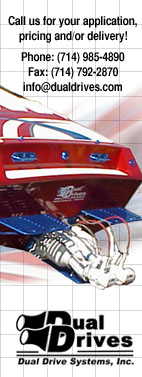|
Frequently
Answer Questions
How
Do Dual Jet Drives Work?
Dual jet propulsion drives draws water in through the intake
cavity (usually located in the base near the rear of the boat) that splits
into two separate dedicated channels and feeds two separate jet units.
Mesh grates are used in the main water intake cavity to stop large objects
from being sucked up. The water is then forced out of a nozzle (located
at the very rear) at high pressure by the spinning impellers. The force
pushing the water out of the rear of the boat is mirrored by an equal
and opposite force accelerating the boat forward.
How
Do Dual Drives Compare With Other Jet Driven Boat?
At the same motor RPM’s Dual Drives have twice the thrust
of a single driven jet boat. Planning, acceleration and maneuvering will
all improve. Pushing or pulling heavier loads can be accomplished with
less motor RPM’s.
Are
Dual Drives Faster Than Propeller Driven Boats?
That all depends on the power to weight ratio and the type
of hull being used. Some boats that we have retrofitted with this system
are faster on top speed with the same power even though the motor was
operating at 1,000 less RPM’s.
Are
Dual Jet Drives Less Efficient Than Propeller Driven Boats?
No, similar and even more economical RPM’s to MPH can be reached.
By matching power, weight and hull design optimum economy can be achieved
without sacrificing planning and acceleration.
Can
The Jets Pick Up Sea Weed, Debris, and Foreign Material?
Yes they can, however the risk is even greater for an underwater propeller.
Most of the time debris will pass through and right out of the jets. With
two jets there is even a better chance that if one of the jets gets debris
in it, the other will keep the boat running and the debris will be pushed
out. However, if debris does need to be cleaned out, there is a clean
out and inspection cover that can be removed to see and remove any foreign
material.
How
Do The Jets Handle Sand, Gravel, Beaching, And Running Aground?
Sucking sand and gravel occasionally is not detrimental to the jet drives
and you will be happy that you do not have a propeller. In continuous
operation the sand or gravel will accelerate the wear on the impeller
and wear rings. Damage can occur, however, repair costs will generally
be much less than with propeller driven boats.
|
